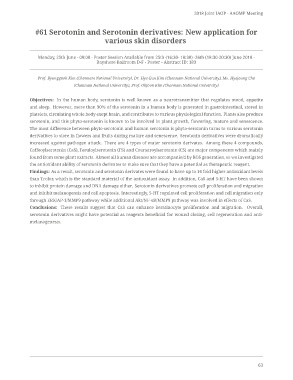Page 89 - AAOMP Onsite Booklet
P. 89
2018 Joint IAOP - AAOMP Meeting
#61 Serotonin and Serotonin derivatives: New application for
various skin disorders
Monday, 25th June - 00:00 - Poster Session Available from 25th (16:30- 18:30) -26th (18:30-20:30) June 2018 -
Bayshore Ballroom D-F - Poster - Abstract ID: 183
Prof. Byunggook Kim (Chonnam National University), Dr. Hye-Eun Kim (Chonnam National University), Ms. Hyejoung Cho
(Chonnam National University), Prof. Okjoon Kim (Chonnam National University)
Objectives: In the human body, serotonin is well known as a neurotransmitter that regulates mood, appetite
and sleep. However, more than 90% of the serotonin in a human body is generated in gastrointestinal, stored in
platelets, circulating whole body exept brain, and contributes to various physiological function. Plants also produce
serotonin, and this phyto-serotonin is known to be involved in plant growth, flowering, mature and senescence.
The most difference between phyto-serotonin and human serotonin is phyto-serotonin turns to various serotonin
derivatives to store in flowers and fruits during mature and senescence. Serotonin derivatives were dramatically
increased against pathogen attack. There are 4 types of major serotonin derivates. Among these 4 compounds,
Caffeoylserotonin (CaS), Feruloylserotonin (FS) and Coumaroylserotonin (CS) are major components which mainly
found from some plant extracts. Almost all human diseases are accompanie/d by ROS generation, so we investigated
the antioxidant ability of serotonin derivates to make sure that they have a potential as therapeutic reagent.
Findings: As a result, serotonin and serotonin derivates were found to have up to 16 fold higher antioxidant levels
than Trolox which is the standard material of the antioxidant assay. In addition, CaS and 5-HT have been shown
to inhibit protein damage and DNA damage either. Serotonin derivatives promote cell proliferation and migration
and inhibit melanogensis and cell apoptosis. Interestingly, 5-HT regulated cell proliferation and cell migration only
through ERK/AP-1/MMP9 pathway while additional Akt/NF-κB/MMP9 pathway was involved in effects of CaS.
Conclusions: These results suggest that CaS can enhance keratinocyte proliferation and migration. Overall,
serotonin derivatives might have potential as reagents beneficial for wound closing, cell regeneration and anti-
melanogenesis.
63

